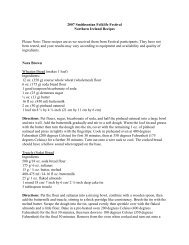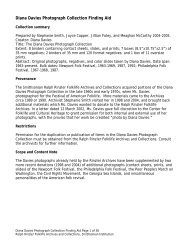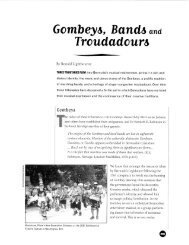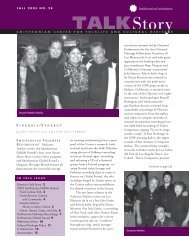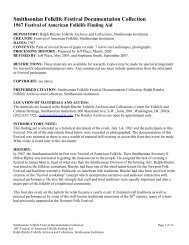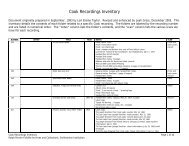Who Owns Traditional Medical Knowledge? - Smithsonian Center ...
Who Owns Traditional Medical Knowledge? - Smithsonian Center ...
Who Owns Traditional Medical Knowledge? - Smithsonian Center ...
You also want an ePaper? Increase the reach of your titles
YUMPU automatically turns print PDFs into web optimized ePapers that Google loves.
MAKING HERITAGE LEGIBLE 173<br />
organization (NGO) has taken this particular cultural claim even further. They<br />
have called for the repatriation of colonial botanical texts like the original Latin<br />
Hortus Malabaricus from libraries in the Netherlands, Portugal, and the United<br />
Kingdom. This is a bizarre variation on selective Native American Graves Repatriation<br />
Act (NAGPRA) policy targeted at libraries, where the preferred strategy chosen<br />
by vulnerable groups is the policy of restricting information from archives<br />
depending on their perceived utility or sacred and ceremonial content.<br />
Whether or not the Ezhava response grows into a social movement or even a<br />
strong political resistance remains to be seen. Meanwhile, the very fact that these<br />
heritage claims are made at all is worth noting. If anything, the larger question<br />
offered up by this case is the indeterminacy of knowing how to locate or separate<br />
local indigenous knowledge in global histories. As the ongoing Hortus Malabaricus<br />
dispute so clearly demonstrates, even if we accept that a colonial text or herbal<br />
fixes local knowledge at a particular point in space and time, it is not clear at<br />
which point they can be (or how they should be) untangled to locate them in<br />
heritage policy.<br />
E-TANGIBLE HERITAGE: THE TRADITIONAL MEDICAL DIGITAL<br />
KNOWLEDGE DATABASE<br />
My second case of Ayurvedic knowledge documentation is the very different example<br />
of a prior art approach to heritage protection. In 1999 the Indian government<br />
fought and won a costly legal battle to revoke a U.S. patent for the medicinal<br />
use of turmeric (Curcuma longa) to heal wounds, a therapeutic property that had<br />
been well known in India for generations. In asserting this TMK as their heritage,<br />
the plaintiff, the <strong>Center</strong> for Science and Industrial Research (CSIR) on behalf of<br />
the state, relied heavily on Ayurvedic texts in the legal brief. Soon after, as part of<br />
a four-year struggle known as the Neem Campaign in 2001, a transnational consortium<br />
of NGOs successfully revoked a similar patent on the properties of neem<br />
(Azadirachta indica) as a fungicide, that had been granted by the European Patent<br />
and Trademark Office. In the brief, well-known antiglobalization activist Vandana<br />
Shiva stated, “The neem tree is India’s sacred goddess . . . our sacred heritage.<br />
Neem in Sanskrit is referred to as sarva roga nivarini—a term that means cure for<br />
all ailments. To take this ancient knowledge from us is blatant and exploitative<br />
biopiracy.” 46<br />
Largely to prevent future patent appropriations of medicinal heritage, the Indian<br />
government launched an exhaustive electronic database of Ayurvedic knowledge,<br />
the <strong>Traditional</strong> <strong>Knowledge</strong> Digital Library (TKDL). This, as various<br />
interlocutors have described, is an example of defensive publishing, a form of negative<br />
protection in the law to prevent the inappropriate exploitation of traditional<br />
knowledge by the developed world, similar to the American Association for the<br />
Advancement of Science’s <strong>Traditional</strong> Ecological <strong>Knowledge</strong> Prior Art Database



